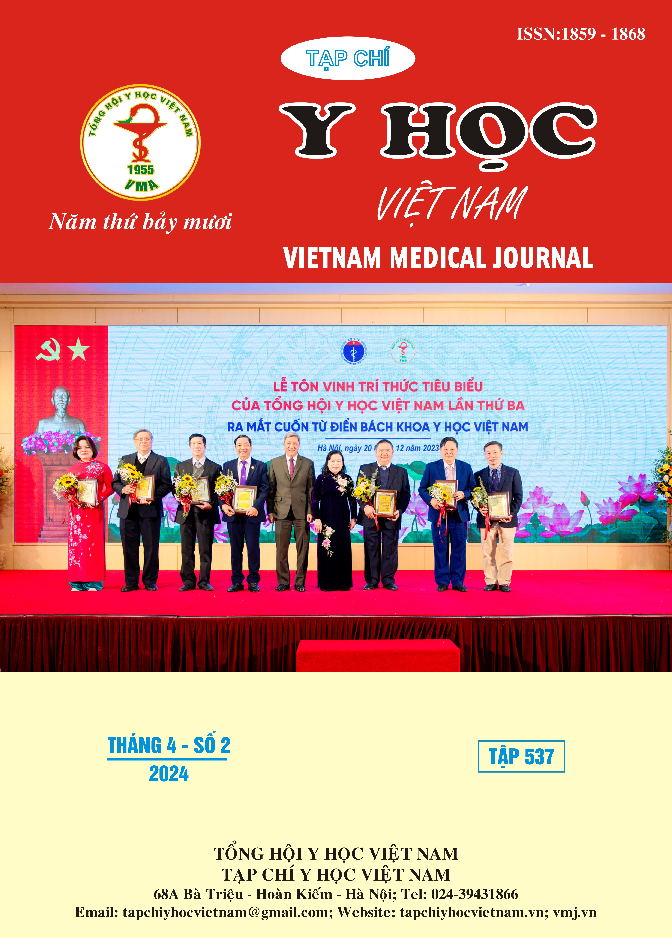CLINICAL CHARACTERISTICS AND TREATMENT OUTCOMES OF TRAUMATIC BRAIN INJURIES IN THE ELDERLY AT THAI BINH GENERAL HOSPITAL
Main Article Content
Abstract
Objective: To assess the characteristics and treatment outcomes of traumatic brain injuries in the elderly at Thai Binh general hospital. Method: This was a descriptive cross-sectional study of 461 elderly patients suffered from traumatic brain injuries treated at Thai Binh General Hospital from April 2021 to December 2022. Results: 461 patients including 300 males (65%), 161 females (35%), The ratio of males to females was 1.86. The average age: 71.51 ± 9.40 years old (from 60 to 99). Causes of injury were falls (47.9%), traffic accidents (43.8%), followed by occupational accidents (2.2%). Mild clinical conditions (GCS 13-15) accounted for (91.5%);the moderate ones were (6.7%), only 1.7% were severe. Acute subdural hematomas were the highest (45.5%); subarachnoid hemorrhages constituted (41.6%); 2 associated injuries made up (28.0%); 3 associated injuries amounted to (14.1%). Nonsurgical treatment aggregated (78.5%), surgery added up to (19.7%), only 1.7% received intensive resuscitation. patient outcomes after hospital discharge demonstrated that Good (88.2%); Fair (7.4%); Bad (1.7%); Death (1.1%). Conclusion: Traumatic brain injuries in the elderly occurs more often in males than in females, the most common cause is falls; Mild clinical conditions predominate; Subdural hematoma is the main type of injuries; Nonsurgical treatment is the main protocol; Rate of bad and death is (2.8%)
Article Details
References
2. G. L. Prasad, N. Anmol, et al, “Outcome of Traumatic Brain Injury in the Elderly Population: A Tertiary Center Experience in a Developing Country,” World Neurosurg., vol. 111, pp. e228–e234, Mar. 2018, doi: 10.1016/j.wneu. 2017.12.034.
3. G. G. Podolsky-Gondim et al., “Traumatic Brain Injury in the Elderly: Clinical Features, Prognostic Factors, and Outcomes of 133 Consecutive Surgical Patients,” Cureus, vol. 13, no. 2, p. e13587, doi: 10.7759/cureus.13587.
4. C. Hawley, M. Sakr, S. Scapinello, et al, “Traumatic brain injuries in older adults-6 years of data for one UK trauma centre: retrospective analysis of prospectively collected data,” Emerg. Med. J. EMJ, vol. 34, no. 8, pp. 509–516, Aug. 2017, doi: 10.1136/emermed-2016-206506.
5. E. Mattingly and C. R. Roth, “Traumatic Brain Injury in Older Adults: Epidemiology, Etiology, Rehabilitation, and Outcomes,” Perspect. ASHA Spec. Interest Groups, vol. 7, no. 4, pp. 1166–1181, Aug. 2022, doi: 10.1044/2022_PERSP-21-00129.
6. O. Skaansar et al., “Traumatic brain injury-the effects of patient age on treatment intensity and mortality,” BMC Neurol., vol. 20, no. 1, p. 376, Oct. 2020, doi: 10.1186/s12883-020-01943-6.


